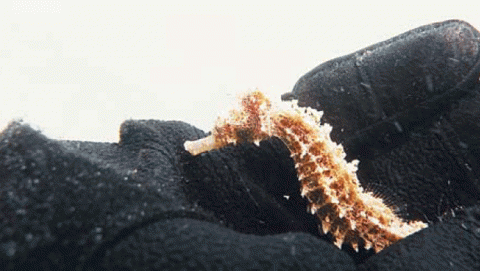The seashores being held in the hand
Divers encounter one in Khiran
Seahorse magic in Kuwaiti waters
Nancy Papathanasopoulou
IT IS shy, very difficult to see under-water. In the very rare occasions spotted, its beautiful shape is recognized as that of a charming little horse, often even sporting a “mane”, which continues down back is elongated, delicate body. The seashore swims softly in upright posture, using its ethereal dorsal fin to direct its way and its tail to grasp itself on marine plants or coral branches.
“Grasping” ensures no waste of energy and the chance to remain steady without getting carried away by currents Escaping from all sorts of predators, such as crabs and tuna is ensured not by speed, but mostly by the ability of changing skin colors, as it camouflages itself in its environment, sometimes completely blending in with amazing expertise.
Having the same mate for life, patiently and carefully, the male seahorse carries the eggs that his female partner gently places inside his pouch, until dozens of hatched tiny seahorses pop out. Calm and peaceful in behavior, but constantly needing to eat because they lack a stomach, these charming fish don’t have teeth and their bodies are covered in plates under their skin. At times there are even filaments on their bodies, which help them look like the grasses in their background. Their life span ranges from one to eight years. They can grow up to 30 cm long and most of the 25 species worldwide are listed as “vulnerable” on the IUCN’s Red List of Endangered Species. Legand has them to be useful for medical purposes, especially in the countries of the Far East, so tent of millions are harvested each year for this purpose, which bares no scientific evidence whatsoever, but decimates seahorse populations world wide. Unsustainable fishing, climate change and the destruction of their main habitats such as sea grass beds, corals and mangroves, poses an important threat for them, too.
In the Arabian Gulf and especially in Kuwait, the sighting of a seahorse underwater is extremely rare, and even more rare is a good, close-up photograph of one. This is the reason why colleague Dinesh Kumar was keen on sharing the information as soon as he and his dive partner encountered the little fellow in Khiran on a recreational dive, just a few days ago. According to the Kuwait Institute of Scientific Research, the only seahorse species record in the country so far is Hippocampus Kuda. So much beauty in such a little animal and further proof of the wonderful marine biodiversity in this country, needing growing and continuous respect and protection.









